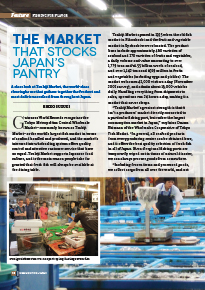Home > Highlighting JAPAN >Highlighting Japan July 2015>Fishing for Flavor
Highlighting JAPAN

Fishing for Flavor
The Market that Stocks Japan’s Pantry
A close look at Tsukiji Market, the world-class clearinghouse that gathers together the freshest and most delicious seafood from throughout Japan.

Guinness World Records recognizes the Tokyo Metropolitan Central Wholesale Market—commonly known as Tsukiji Market—as the world’s largest fish market in terms of seafood handled and produced, and the market’s intermediate wholesaling system offers quality control and attentive customer service that have no equal. Tsukiji Market supports Japanese food culture, and is the main reason people take for granted that fresh fish will always be available at the dining table.
Tsukiji Market opened in 1935 when the old fish market in Nihonbashi and the fruit and vegetable market in Kyobashi were relocated. The product lines include approximately 480 varieties of seafood and 270 varieties of fruits and vegetables, a daily volume and value amounting to over 1,779 tons and ¥1.55 billion worth of seafood, and over 1,142 tons and ¥319 million in fruits and vegetables (including eggs and pickles). The market welcomes 42,000 visitors a day (November 2002 survey), and admits about 19,000 vehicles daily. Handling everything from shipments to sales, operations run 24 hours a day, making it a market that never sleeps.
“Tsukiji Market’s greatest strength is that it isn’t a producers’ market directly connected to a particular fishing port, but rather the largest consumption market in Japan,” explains Osamu Shimazu of the Wholesales Cooperative of Tokyo Fish Market. “In general, all seafood products from every producing center can be obtained here, and it offers the best quality selection of fresh fish in all of Japan. Even if regional fishing ports are temporarily wiped out in times of natural disaster, we can always procure goods from somewhere.
“Including frozen items and processed goods, we collect cargo from all over the world, and not only high-end products—we can also provide the most suitable products to fit our customers’ budgets and needs,” Shimazu adds. “Even with the same type of fish, there are differences in how to prepare it to get the most delicious flavor out of it, whether it’s as sashimi or grilled with salt. The ability to understand that and offer a product that best fits the customer’s needs depends on the abilities of the intermediate wholesaler as a connoisseur.”
With the popularization of the Internet and an increase in customers who order products directly from regional fishing ports and fishermen, the necessity of intermediate wholesalers between buyers and sellers has come under debate, but it is these concierge-like abilities of the “connoisseur broker,” as well as his or her power to assemble wholesale cargo, that are cited as the advantages of Tsukiji Market.
“Because we are such a large market, each merchant works diligently to provide the best product, and that is a defining characteristic of Tsukiji Market,” Shimazu explains. “There are seven seafood wholesaling companies here, whereas in a regular market you would often find only one. There are over 630 intermediate wholesalers, and each provides attentive service to fulfill their customers’ needs. At every location of this system, built like a spider’s web, there are professionals checking and verifying the quality of products at Tsukiji Market. I believe that you can understand the value in that.”
The market system in place here, made possible through these intermediate wholesalers, has attracted a great deal of interest from overseas. In fact, Vietnam is reportedly considering adopting the same system. And in terms of fish exports, due to an increase in orders from Southeast Asia, Hong Kong, Taiwan and North America in recent years, the Wholesales Cooperative of Tokyo Fish Market is preparing a support system to handle and simplify the procedures as a way to reduce the burdens imposed on individual wholesalers in anticipation of the scheduled move of the market to nearby Toyosu in 2016.
“As interest in Japan rises as we approach the Tokyo Olympics in 2020, our goal is to show the world how wonderful Japanese food culture is,” Shimazu says with great enthusiasm. It’s only natural that supplying fresh, delicious fish to households and restaurants is the foundation for maintaining the importance of seafood in Japanese food culture. Since Tsukiji Market makes that possible, it can truly be called the pantry of Japan.
© 2009 Cabinet Office, Government of Japan






